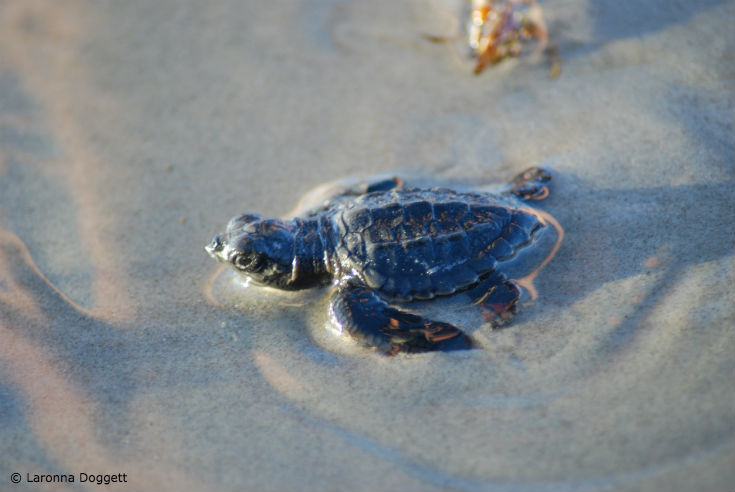Creating a Healthy Future for Sea Turtles
Published by Ocean Conservancy
I wasn’t really awake until our all-terrain vehicle bumped its way to the beaches of the Alabama Gulf coast. I held on tight in the dark and wondered whether this adventure had been such a good idea after all.
Then a pop of orange and red burst across the Gulf of Mexico. All that had been asleep was now vivid and busy. Sea gulls and terns swooped above the waves scanning for breakfast. A pod of dolphins broke the surface offshore. Salty fishermen appeared as the mist lifted, persistent, patient. I remember being on the beach early each morning during the BP oil disaster. Even through all the chaos the mornings were always magical as the sun rose over the Gulf. Six years later it is reassuring to see so much is well, but we know that there is still work ahead to restore this environment to its natural state. As I took in all these sights, I reminded myself: I’m here to do a job.
I had signed up with Share the Beach, a volunteer conservation program that monitors and helps protect sea turtles as they are about to hatch. The Gulf is home to many sea turtle species, including: loggerhead, leatherback, hawksbill, green and Kemp’s ridley. Each of these five species is listed as threatened or endangered and could become extinct if measures aren’t taken to support their populations.
One way to help these iconic creatures is to protect their nests and give young turtles the best chance to survive and return to the sea. If we find a nest, we lay metal fencing on the sand to protect the eggs from predators and flag the area so people know it shouldn’t be disturbed. On rare occasions, mother turtles lay their eggs too close to the high tide mark. In those cases, we carefully move the nest and eggs to higher ground so the nest won’t be inundated with water, which might kill the hatchlings.
When the eggs have been incubating in the sand for 55 days, we begin to “nest sit.” Volunteer teams watch the nests around the clock until the babies hatch. Our goal is to make sure the baby turtles reach the Gulf waters without a hitch. Many times, the baby turtles become disoriented, confusing street lights and porch lights on the land with the horizon offshore. If they head to manmade lights, we redirect them to the water. This year, Alabama had a record nesting year, which means there is hope for recovery, resilience and restoration in spite of the many stressors on the environment.
Ocean Conservancy’s new video focuses on that hope. It begins with a sea turtle that hatched in 2010 during the height of the BP oil disaster. Skipping ahead to the year 2045, the sea turtle returns to the same beach where she hatched to lay her own eggs. But, thanks to the efforts of people like you to restore the Gulf, she doesn’t find an oil laden beach; she finds a pristine environment teeming with life. That’s the future Ocean Conservancy works to achieve each day.
Join Ocean Conservancy to help create a healthy future for sea turtles and all who rely on the Gulf. Last month, the Gulf Coast Ecosystem Restoration Council released its updated plan to restore the Gulf of Mexico. Please join us in thanking the Council for their work and asking them to take the plan a step further. Help us generate 20,000 comments to the Council to ensure a healthy future for Gulf species like sea turtles.
Read the full article at: http://blog.oceanconservancy.org/2016/09/23/creating-a-healthy-future-for-sea-turtles/




